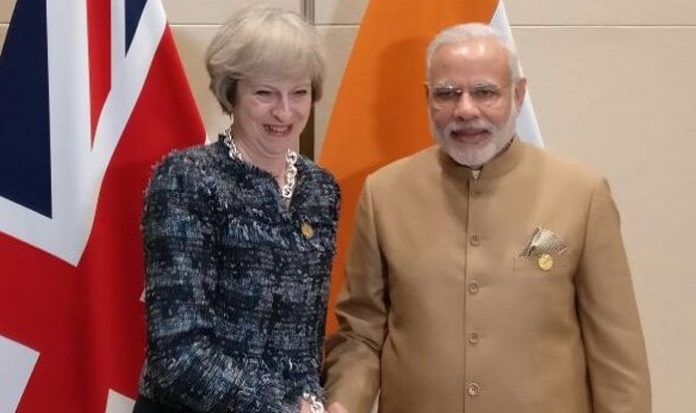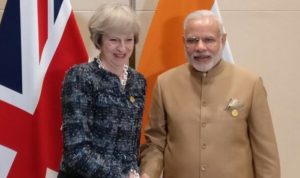British Prime Minister Theresa May arrived in Delhi on a three-day visit(November 6-8, 2016) aimed at enhancing Indo-UK ties in the key areas of trade, investment, defense and security.
About Theresa May,
Theresa Mary May is the Prime Minister of the United Kingdom and the Leader of the Conservative Party, in office since July 2016. She has also been the Member of Parliament (MP) for Maidenhead since 1997.
- May identifies as a one-nation conservative and has been characterised as a liberal conservative. May is the second woman to hold the post of British prime minister, following Margaret Thatcher (1979–1990).
- The daughter of avicar, May grew up in Oxfordshire. From 1977 until 1983, she worked for the Bank of England, and from 1985 until 1997 at the Association for Payment Clearing Services, also serving as a councillor for Durnsford in Merton.
- After unsuccessful attempts to be elected to the House of Commons in 1992 and 1994, she was elected as the MP for Maidenhead in the 1997 general election.
- From 1999 to 2010, May served in a number of roles in the Shadow Cabinets of William Hague, Iain Duncan Smith, Michael Howard, and David Cameron, including Shadow Transport Secretary and Shadow Work and Pensions Secretary. She was also Chairman of the Conservative Party from 2002 to 2003.
- After the formation of a coalition government following the 2010 general election, May was appointed Home Secretary and Minister for Women and Equalities, giving up the latter role in 2012.
- Reappointed after the Conservative victory in the 2015 general election, she went on to become the longest-serving Home Secretary since James Chuter Ede over 60 years previously.
- During her tenure she pursued reform of thePolice Federation, implemented a harder line on drugs policy including the banning of khat, oversaw the introduction of elected Police and Crime Commissioners, the deportation of Abu Qatada, the creation of the National Crime Agency and brought in additional restrictions on immigration.
- Following the resignation of David Cameron on 24 June 2016, May announced her candidacy for the leadership of the Conservative Party and quickly emerged as the front-runner.
- She won the first ballot of Conservative MPs on 5 July by a significant margin, and two days later won the votes of 199 MPs, going forward to face a vote of Conservative Party members in a contest with Andrea Leadsom. Leadsom’s withdrawal from the election on 11 July led to May’s appointment as leader the same day.
- She was appointed Prime Minister two days later, the second woman to hold both offices. On becoming Prime Minister, May became the first woman to have held two of theGreat Offices of State.
About her Visit to India :
India and the UK on Monday inked two pacts with British Prime Minister Theresa May arguing for a bilateral free trade arrangement, distinct from New Delhi’s proposed deal with the European Union.
- May and Prime Minister Narendra Modi witnessed the signing of the two Memorandums of Understanding – one on intellectual property (IP) and another for bilateral cooperation on raising ease of doing business.
- The first MoU inked on November 6, 2016 to envisages establishing a mechanism for furthering cooperation between the Intellectual Property Offices of India and the UK in the field of intellectual property and related information technology services.

- The second MoU intends to make expertise from different British government departments, which have led the ease of doing business drive in the UK, available to the relevant departments and agencies of the Government of India.
- India and the United Kingdom have agreed to enhance defence ties with a view to expanding military trade and industrial collaboration.
- The agreement was announced during UK prime minister Theresa May’s three-day visit to the South Asian country. India and the United Kingdom had ambitions in the defence sector to “design, make, exercise, train and co-operate together”.
- It is noted that the two countries have agreed to “encourage and facilitate” opportunities under New Delhi’s ‘Make in India’ campaign, which seeks to encourage co-operation between defence exporters and Indian industry.
- Prime Minister Narendra Modi and British PM Theresa May pledged to extend cooperation in trade and green energy in the India –UK Tech summit, 2016.
- India and the U.K. must help each other break down barriers and Britain is helping India improve its ease of doing business and also determined to go further.
India-U.K. bilateral trade has remained the same in the last five years and India was the third-largest investor in the U.K. Science, technology and innovation have a significant role in India’s bilateral engagement with the U.K and in order to boost entrepreneurship, science and technology is very important and it also has a very significant role in our relationship.
United Kingdom (UK) :
♦ Capital: London
♦ Currency: Pound sterling






